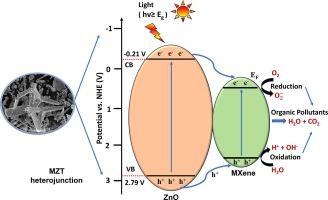用于高效降解甲基橙、亚甲基蓝和罗丹明 B 染料的 MXene 装饰氧化锌四元结构
IF 3.9
3区 材料科学
Q2 MATERIALS SCIENCE, MULTIDISCIPLINARY
引用次数: 0
摘要
首次报道了使用 MXene 装饰的氧化锌四元结构(MZT)降解甲基橙(MO)、亚甲基蓝(MB)和罗丹明 B(RhB)染料。MXene 是通过高频蚀刻从 MAX 相中提取的,而 ZT 则是通过火焰传输合成(FTS)技术生产的。通过将 MXene 和 ZT 组成的去离子水混合和超声处理,在 ZT 上装饰了 MXene。使用 X 射线衍射 (XRD)、紫外可见光谱、陶氏图分析、布鲁诺-艾美特-泰勒 (BET) 表面积测量、场发射扫描电子显微镜 (FESEM) 和高分辨率透射电子显微镜 (HRTEM) 对 MZT 进行了表征,以确保装饰成功。针对三种染料测试了 MZT 的染料降解能力:MO、MB 和 RhB。日光下的光降解测试表明,RhB 的效率最高(77.60%),其次分别是 MO(76.79%)和 MB(50.83%)。动力学速率常数证实了 RhB 的卓越降解能力。此外,电子顺磁共振(EPR)光谱显示了氧空位,从而提高了光催化性能。MZT 保持了较高的效率,4 次循环后的损耗小于 20%,这表明它具有在废水处理和减轻环境污染方面反复使用的潜力。研究结果揭示了 MZT 在光催化降解有害有机染料方面的潜力,是一种非常有前途的治理环境污染的解决方案。本文章由计算机程序翻译,如有差异,请以英文原文为准。

MXene decorated ZnO-tetrapod for efficient degradation of Methyl Orange, Methylene Blue, and Rhodamine B dyes
For the first time, Methyl Orange (MO), Methylene Blue (MB), and Rhodamine B (RhB) dyes degradation using MXene decorated ZnO-tetrapod (MZT) has been reported. MXene was derived from MAX phase using HF etching and ZT was produced using flame transport synthesis (FTS) technique. MXene was decorated on ZT using blending and sonication of deionized water consisting of MXene and ZT. The MZT was characterized using X-ray diffraction (XRD), UV–visible spectroscopy, Tauc plot analysis, Brunauer-Emmett-Teller (BET) surface area measurement, field emission scanning electron microscopy (FESEM) and High-Resolution Transmission Electron Microscopy (HRTEM) to ensure the successful decoration. The dye degradation capability of the MZT was tested against three dyes: MO, MB, and RhB. Photodegradation tests under sunlight showed RhB had the highest efficiency (77.60 %), followed by MO (76.79 %) and MB (50.83 %), respectively. The kinetic rate constants confirmed RhB’s superior degradation. Furthermore, Electron paramagnetic resonance (EPR) spectroscopy revealed oxygen vacancies, enhancing photocatalytic performance. MZT maintained high efficiency, with less than 20 % loss after 4 cycles, demonstrating its potential for repeated use in wastewater treatment and environmental pollution mitigation. The results reveal the potential of MZT in photocatalytic degradation of harmful organic dyes, very promising solution for combating environmental pollution.
求助全文
通过发布文献求助,成功后即可免费获取论文全文。
去求助
来源期刊

Materials Science and Engineering: B
工程技术-材料科学:综合
CiteScore
5.60
自引率
2.80%
发文量
481
审稿时长
3.5 months
期刊介绍:
The journal provides an international medium for the publication of theoretical and experimental studies and reviews related to the electronic, electrochemical, ionic, magnetic, optical, and biosensing properties of solid state materials in bulk, thin film and particulate forms. Papers dealing with synthesis, processing, characterization, structure, physical properties and computational aspects of nano-crystalline, crystalline, amorphous and glassy forms of ceramics, semiconductors, layered insertion compounds, low-dimensional compounds and systems, fast-ion conductors, polymers and dielectrics are viewed as suitable for publication. Articles focused on nano-structured aspects of these advanced solid-state materials will also be considered suitable.
 求助内容:
求助内容: 应助结果提醒方式:
应助结果提醒方式:


